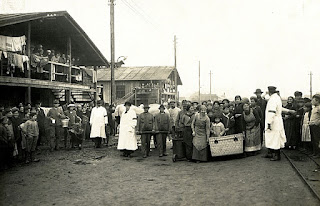 |
| Italian deportees at Wagna Refugee Camp, c. 1915 |
(Written by Lorenzo Salimbeni, taken from the newspaper “Il Giornale d'Italia”, November 20, 2017.)
Italians living around the base of Pola were transferred to internment camps
At the outbreak of the First World War the Austro-Hungarian Empire issued evacuation measures for their strongholds, with obvious reference to those that were close to the border with Russia, the scene of the first battles, but also the city of Pola was part of this measure. The Istrian city, in fact, was the main naval base of the imperial war fleet and therefore a call was issued that urged the population to prepare for any special measures. In the spring of 1915, when the movements of the Kingdom of Italy signaled its entry into the war against Austria, the first calls for the evacuation of civilians were made. Some organized themselves with their own means, moving in with friends and relatives residing in other places of the Empire; as regards the Italian citizens residing in the Adriatic Coast, the so-called "regnicoli", those fit for military service were collected in special internment camps, while women, children and the elderly were gradually able to return home through Switzerland.
The exhortation to evacuate first pertained to Pola and southern Istria, then expanded to Rovigno and central Istria, so it is estimated that about 50,000 people (out of a population of 100,000) were loaded onto trains and taken to barracks camps built in Styria or near Vienna. Those destined to live in these Barackenlager first had the traumatizing experience of the interminable journey (in memoirs we often find the word "invaginated", i.e. enclosed or turned inside out, which gives a good idea of how these people had been crammed into cattle cars), after which they experienced the shock of the structures in which they would be forced to live. Wagna, for example, the most famous of these camps, was created from the hasty expansion of a military training camp, in which the buildings were full of drafts and each barrack contained a hundred people gathered in precarious hygienic-sanitary conditions and in extremely close proximity. The Habsburg authorities guaranteed a daily allowance to everyone, but if someone could find work in the area or preferred to settle in a better structure outside the camp, he would lose this small pay. The poor living conditions of the internees of Italian nationality were in vain brought to the Parliament of Vienna by the Deputies Alcide De Gasperi, with special reference to the Trentino, and Valentino Pittoni, who sought to protect the displaced Italians from the Adriatic Littoral. During the so-called "Events of Wagna" the troops stationed to guard the camp (managed in such a way as to resemble more a prison than a shelter for refugees) suppressed a protest demonstration so forcefully that they killed a victim.
When the Italian army was forced to retreat to the Piave, the Adriatic Littoral regained security and the refugees began to return, but so slowly that, in the strikes that shook the Empire at the end of January 1918, workers and military demonstrators in Pola also demanded the immediate return of their relatives. The local administrators did not make significant efforts to help the reintegration of refugees, appealing to the technicality that Pola, Rovigno and the county had never been officially "evacuated", since the authority was limited to "advising" people to leave. Those who were still living in the Barackenlager experienced the national conflicts that were shaking the foundations of the Empire, since the committee that had arisen among the refugees of the Littoral to report to the administrators of the camps lost its solidarity. This committee had always been presided over by representatives of Italian nationality, as Italians were the majority component of displaced persons of the Province and in any case the other ethnic groups were never discriminated against; however, the Slavic and German elements in the first months of 1918 created alternative structures of representation in order to highlight their own specificity in the presence of the Habsburg administration.
Due to the convulsive final phase of the Empire, the return of the displaced Istrians ended only in the first months of 1919, under the Italian military authorities that had in the meantime taken up positions in Julian Venetia.
